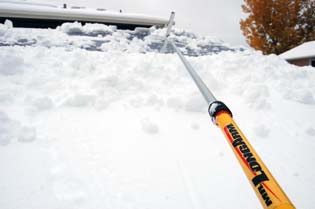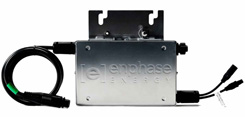
 Snow cover can shut down your solar system for days and days, even in blue-sky, sunny conditions, as our own experience in Aurora, Colo. has repeatedly shown us.
Snow cover can shut down your solar system for days and days, even in blue-sky, sunny conditions, as our own experience in Aurora, Colo. has repeatedly shown us.
We haven’t come up with the ideal solution yet – and clearly neither has the solar industry – but below are some different approaches to dealing with snow-covered solar panels.
1. Wait until it melts. This is a good solution for people with rooftop solar systems at a relatively steep pitch – at least 35 degrees or more. Chances are, especially in a place with weather patterns such as Colorado’s Front Range where snowstorms are typically followed by multiple pure blue-sky days, it’ll slide off quickly. But, again, it will only do so if your roof pitch is steep enough – which ours, at 19 degrees, clearly is not.
2. Sweeping solar panels free of snow. This can be tricky, dangerous, or even impossible for many rooftop systems. But it’s worth a try in the case of many other systems. In our case, I can reach the lower 13-panel string of our 26-panel, 5.59 kW system with a 23-foot Mr. Longarm – but only if I climb up on a ladder to do so. Another product that gets mentioned quite a bit in online chatter about snow on panels is the roof rake from RoofRake.Com.
3. Build a system on racks that put the panels at at least a 35-degree angle. The greater the tilt angle, the more quickly the snow will slide off the panels. By the same token, if the angle is too shallow, it may rarely, if ever, slide off. Of course, putting your rooftop system on tilts makes it uglier — at least I think it does — and this might be nixed by an HOA. On the other hand, a rooftop system on a tilted rack will not only shed snow more easily in the winter, it’ll be more efficient in the non-snow months. My sister actually suggested a hydraulic rack system that could be tilted to shed snow and then moved down again. I’m not sure if such a home solar racking system exists, but it is an intriguing idea.
 4. Apply warm air to the system to speed up snow melting. This seems like a decent idea – if you can figure out a way to do it efficiently, safely, and, if you live in an HOA like we do, in an aesthetically acceptable way. Some suggestions I’ve seen online, include creating a system of long plastic air hoses/PVC pipes that you then connect to a leaf blower. This system either blows snow off the top of the panels or blows warm air under the panels to speed up melting.
4. Apply warm air to the system to speed up snow melting. This seems like a decent idea – if you can figure out a way to do it efficiently, safely, and, if you live in an HOA like we do, in an aesthetically acceptable way. Some suggestions I’ve seen online, include creating a system of long plastic air hoses/PVC pipes that you then connect to a leaf blower. This system either blows snow off the top of the panels or blows warm air under the panels to speed up melting.
5. The Nerf ball approach. This essentially involves throwing a soft, spongy ball on the system to get some snow off and speed up the melting process. Though it might work for some, I’m skeptical it will help much in our case, especially with big storms that dump 10, 12, or 14 or more inches of snow. Of course, I haven’t tried it, so it could be more effective than I think.
6. Ice melt sock. I’ve seen this suggested in multiple places online, but I’m skeptical about its effectiveness. I’d also be concerned about possible corrosive damage to the system. You’re supposed to put a calcium chloride compound in a sock-like device and put several of these at the top of your system (not on top of it, at the top). Then, supposedly, the calcium chloride will quickly melt through the snow and ice and create a channel for water to flow down, creating the conditions for quicker snow slide off and melting.
7. Heat tape. Quite a few suggestions out there involve affixing heat tape to various parts of your solar panels, although I can’t find much in the way of talk about how effective this. To me, it seems like a fire hazard, though perhaps I am being too anxious.
8. Spraying snow off with a garden hose. Given the typical winter climatic conditions on Colorado’s Front Range, which often see a big snowstorm followed by a stretch of sunny days with highs in the low to mid 40s, for us, I am beginning to think this may be the best/easiest solution. That’s why I put the hose in the garage after our last snowstorm, where it won’t freeze up. I’ll be out there with our hose after our next snowstorm. However, I wouldn’t recommend spraying your system with water in freezing temperatures — which why this is clearly not a solution for everyone.
 9. Microinverters. Microinverters, which allow individual panels to produce at their highest possible output regardless of what other panels around them are doing, are a partial solution to snow on solar panel situations, at least situations of our type in which we see a large percentage of our 26-panels become snow free, only to watch them produce nothing at all thanks to other panels on the same “string” that remain fully, or partially snow-covered.
9. Microinverters. Microinverters, which allow individual panels to produce at their highest possible output regardless of what other panels around them are doing, are a partial solution to snow on solar panel situations, at least situations of our type in which we see a large percentage of our 26-panels become snow free, only to watch them produce nothing at all thanks to other panels on the same “string” that remain fully, or partially snow-covered.
10. A pulley-operated tarp system. One of our readers suggesting building a system of pulleys with a large tarp attached. Pull the tarp over the panels before a storm, then pull the tarp down, ideally with the snow on top of it, after the storm, and, voila, you’ve got snow free panels. A good idea! However, in our case possible aesthetic and logistical/safety issues in setting up the system are an impediment.
11. Volotek’s self-cleaning solar panels. According to Volotek – which describes itself as “a leader in the design and manufacture of high precision instruments and renewable technologies” – their solar cleaning technology “creates an electrostatic field that repels the dust or the sand and carries it outside the surface. It also determines if the surface is covered with snow, then it starts a heating element to melt down the snow.” This sounds intriguing, although it’s unclear exactly how it works, how much energy it takes, and if you can even buy Volotek products at all.
12. The mystery ‘snow melt for PV panels solution’. I came across this solution via a Google search. It appears to involve a soft material that has heat nodes in it being attached to the back of solar panels. However, as with Volotek’s self-cleaning panels, there’s no information on how to purchase this product or how much it might cost. I also have safety worries about it.
So, there you have it: An even dozen possible solutions to the problem of snow on solar panels, none of them perfect.
For us, it appears hosing panels off with water using a garden hose might often be the best approach, although I have to say, I haven’t tried it to see how it’ll work with 10, 12, or 14 inches of snow. I’ve only tried with about two inches of snow on the panels – and it seemed to show some promise.
Check back to see if it works with deeper snow after our next snowstorm here on Colorado’s Front Range 😉
Related artlcies–>




